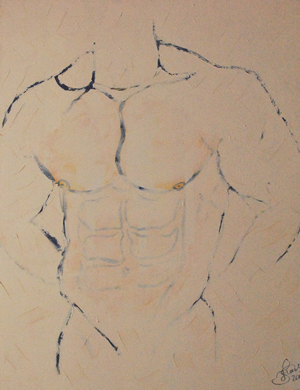The body of a body builder is one which can provoke many reactions: we are in awe; we marvel at the dedication and decision it takes to achieve it; we think of beauty, of desire, of narcissism; we wonder at the obsession with a certain body type and ideal – we might even question or disprove of the body type and the motives behind wanting to look that way.
However, no matter what other thoughts might come to mind, the bodybuilder’s body is a living testament, indicating an intense drive, determination and focus. Through diet, sleep, life choices and regulated work outs, the bodybuilder dedicates his or her life to achieving the ultimate goal, the perfection of their body.
I paint the bodybuilding form because of what it represents to me: dedication, commitment, and the wondrous ability of the human being to change and enhance our appearance.
Bodybuilding presented to me the ultimate ideal of what I always wanted. Growing up, I was the baby of the family: not only was I the youngest, I was a thin, frail boy. I was very unhappy with my appearance, and did not like the softer look I had. I was almost ashamed to look in the mirror at my small body; I wanted to raise my body to the level of fitness and health that I saw in bodybuilding. As such, I began to work towards my goal of having the bodybuilder’s body.
The ancient Egyptian pharaohs built temples to the gods, and further adorned the temple walls with iconography, with rich art depicting the gods – all as part of their own deification process, as pharaohs themselves conducted their lives with the belief and desire to become gods in the afterlife. Like these pharaohs, I began to build my own temple – my body. Like the pharaohs, I surrounded myself with art work, with representations of the ideal figure. I drew and painted out what I wanted to be like, capturing my ideal figure on canvas. Art allowed me to express my hopes and desires; it was a visual representation of the ideal I had in my mind.
From this process came three acrylic paintings of body builders, now called Blue Night , Red Night and White North, respectively. Yet before I renamed them, these paintings went by other titles, titles that were more indicative of my thought process, of the impulse behind the art. I would like to share them with you now, so that you might be able to step into my mind a bit, to step into the process.
Originally, White North was called “The Birth of an Idea”, representing the blank canvas state from which ideas spring. I was unsatisfied with this title, however, as I was also unsure of the state of the painting: was it finished? Was this the final product, or was there more to create with it? It became “The Incomplete Picture” – I could not decide where to take the painting from the white state it was in. Indeed, it remained unsigned for two whole years before I came to the realization that this was the final state – rather than the beginning or birth of an idea, it is the final stage of an idea. It thus became The White North, to indicate the final frontier, the very ends of the earth, the culmination of a journey.
Blue Night was originally titled “The Resurrection”: it represents the body type that I, having shed my former body which I was unhappy with, was able to rise to. It is a celebration of reaching that ideal, of finally being able to achieve happiness and delight in one’s self. This painting represents what hard work can achieve: the ultimate look. The background signifies a perfect summer day, the kind of day where you rejoice in being alive, in being happy and healthy. The vibrant blue is the cloudless blue sky of such a day, a sky with no threat of bad weather – no worries, only celebration.
The red acrylic painting, Red Night, was painted with the same joyful thoughts in mind. It was originally titled “The Reincarnation”: a celebration of rebirth, of lifeblood pulsing, surging through. With the right attitude, you can allow what you dislike in yourself to die – you can find a new body, a new being in which to wake. The longer you work, the longer you do the right things (diet, fitness), the closer you can get to your ideal form or goal, constantly improving, moving forward, leaving what disappoints you far behind in the dust of a former life.
All of these body building paintings were not just a delight in the human body; rather, they were at once my message of hope, of the possibility for change, and my celebration in this fulfillment, in finding an ultimate new state of happiness and self-hood, of finally finding a home for my identity.



























